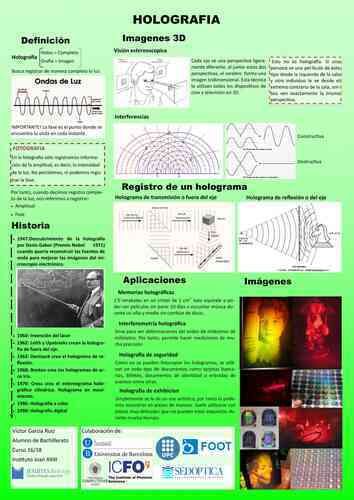Holografia
víctor garcía ruiz
jesuïtes bellvitge joan XXIII – L’hospitalet de llobregat
The holography is based in “holos” which means complete or full and “graphy” which means image, so holography is the record of the entire image. For that, we need to record wave amplitude and the wave phase. The difference between the photography is the record of wave phase. But not all the tridimensional images are holography; the cinema and TV uses stereoscopic view for create the 3D effect. Let me give an example. If a cinema room is full of people and they see a 3D film, all of them can see the 3D effect, but they see the same perspective. If all of them see a hologram, each one has a different perspective depending on the place of the room where they are.
The history of holography starts in 1947 with Denis Gabor who won the Nobel. Some years after, the laser was discovered and it improved the holography. After that, some scientists created different types of holography, but all of them are based in on-axis holography or in off-axis holography.
We must know what interference is, because in the holographic plate we create an interference pattern. The interference is the sum of two waves. It can be constructive if both go at the same time or destructive if each one goes in a different time. For recording a hologram we must do interferences between the reference and the object beam, they create the pattern in the holographic plate.
The applications of this optical phenomenon are: Holographic memories (probably the most powerful memory), holographic interferometer (used by engineers to see small deformations), security holograms (we can see it in ID cards, bank cards, tickets for events …) and probably the most used are the exhibition holography.


